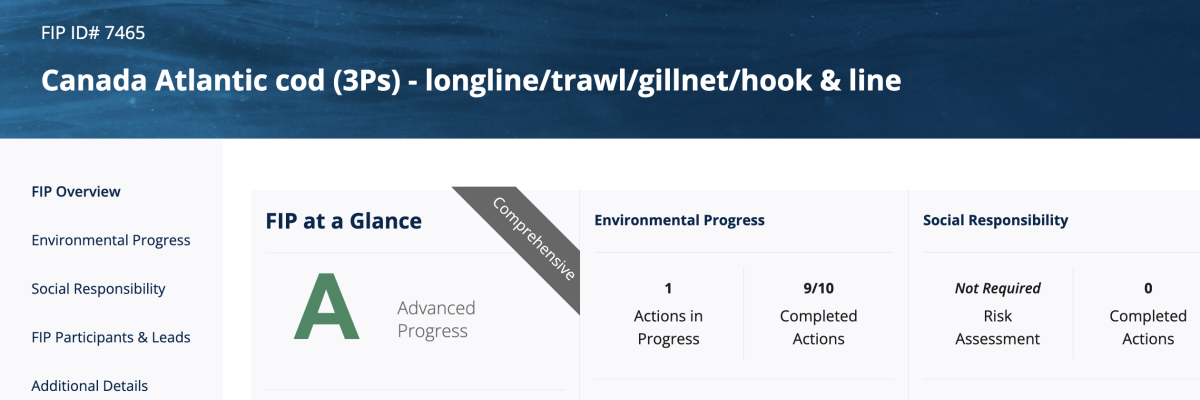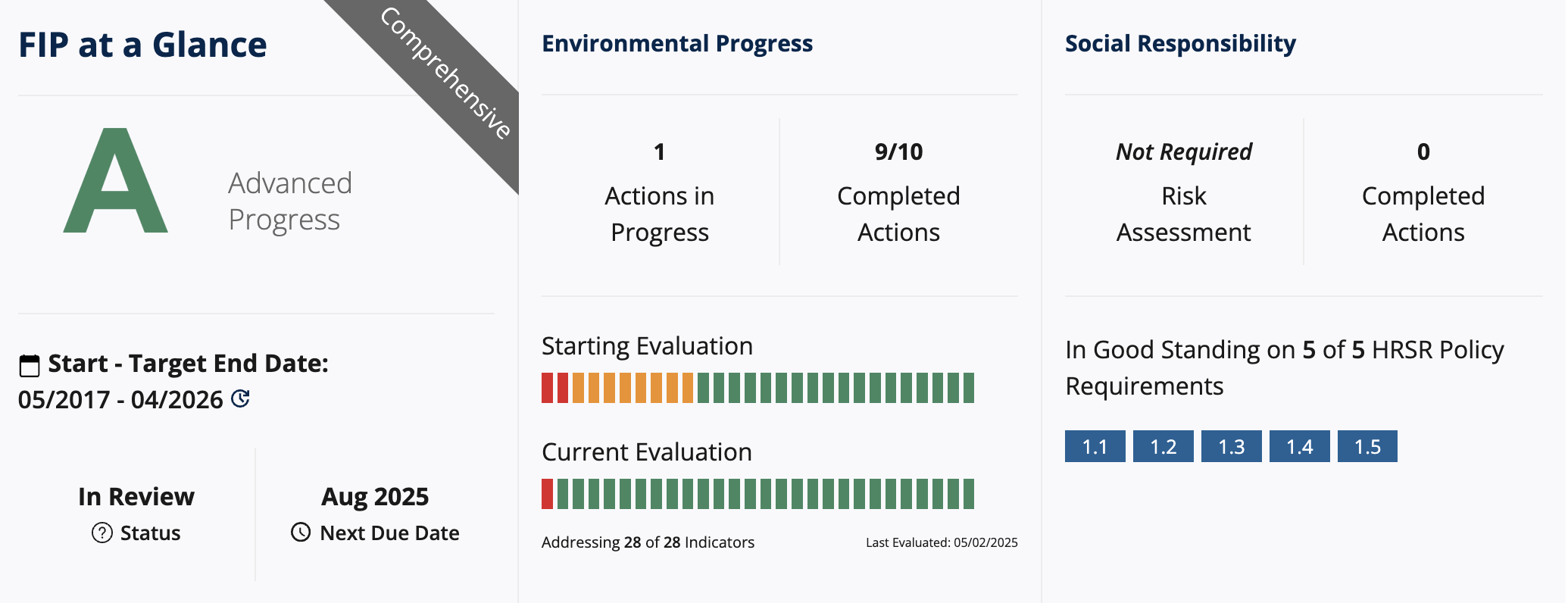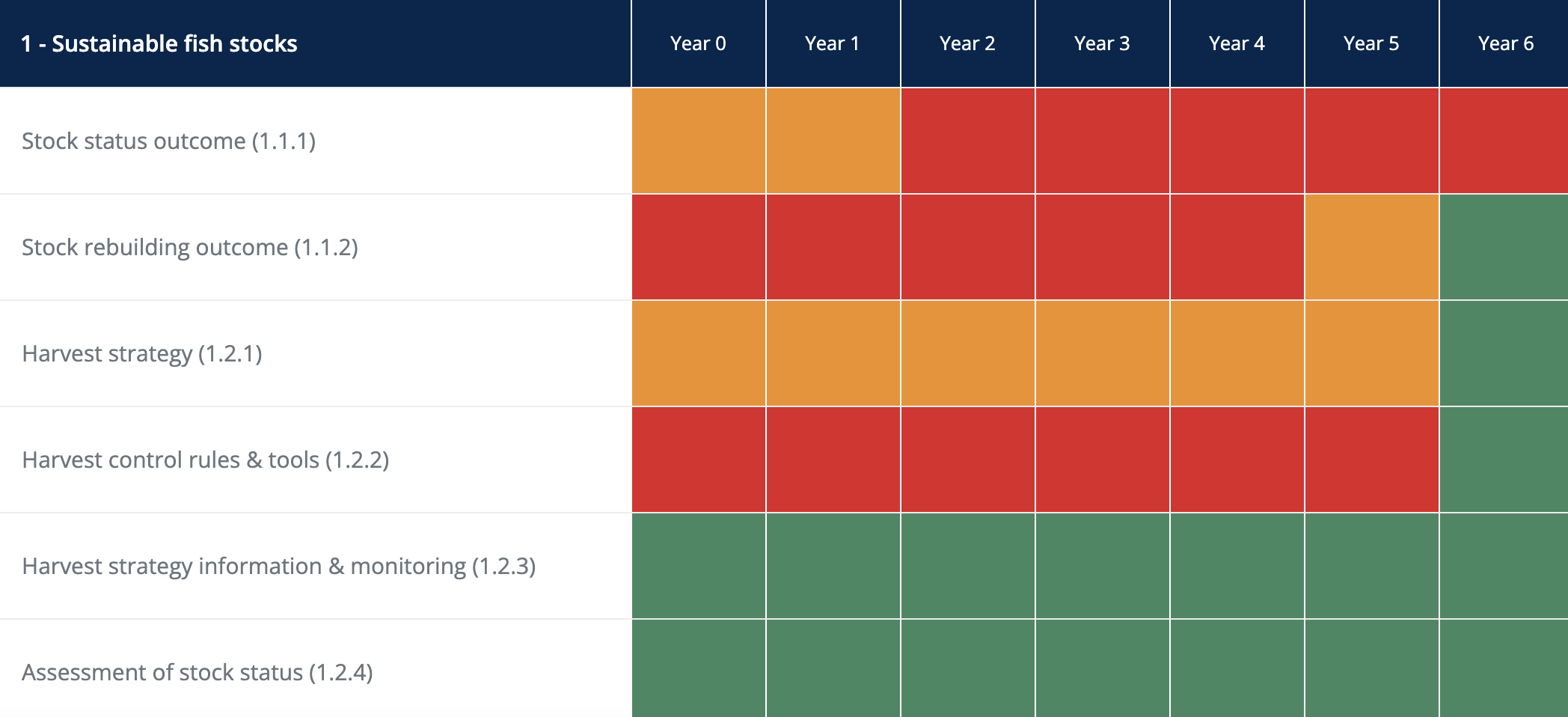
With the redesigned FisheryProgress website comes a refreshed layout for all Fishery Improvement Project (FIP) profiles. The profiles still include all the information you’re used to, plus some new features to help you better understand a FIP’s environmental and social progress. Here’s a quick guide to help you get the most out of the new setup.
The main way to navigate to a FIP’s profile is through the FIP Directory. Here, you can search for the FIP directly or choose various filters to help you pinpoint the FIPs you’re searching for.
The FIP Overview Page: Your Starting Point

Upon entering a FIP profile, you’re taken to the FIP Overview page, where viewers can get an array of information upfront. You’ll find the FIP’s environmental progress rating, followed by a snapshot of the FIP’s environmental and social progress. Under the environmental section, the starting evaluation reflects the status of indicators from the FIP’s pre-assessment or needs assessment at the time the FIP began. The current evaluation shows the status of those same indicators based on the most recent year of reporting. Ideally, a FIP that is making progress will have fewer red indicators and more yellow and green ones—demonstrating that environmental concerns have been addressed over time. For social responsibility, “In Good Standing” reflects the FIP’s progress against the updated Human Rights and Social Responsibility (HRSR) Policy; knowing that some requirements are more ongoing in nature, the new policy steers away from compliance oriented language and focuses on improvements made over time.
Key Details About the Fishery
Moving down, you’ll find information about the type of FIP, start and end dates, and its current stage. This section also includes information about the species targeted, gear types used in the FIP, and annual landing statistics. The new profile includes updated information about where the FIP is located, including country information and a map displaying where the fishery operates. FIPs now even have the option to draw the boundaries of their FIP’s operation on the map.
About This FIP: Background and Objectives
Each FIP provides its own overview of its fishery in the “About this FIP” section, including information on its history, those who are involved, and a rundown of the FIP’s objectives. As of the website re-launch, all FIPs are being asked to add at least one FIP objective related to human rights and social responsibility within the next year, to reflect the fact that this work is integral to the FIP. Below this section, you’ll find information about the FIP Leads and their contact information. You’ll find a full list of FIP participants in the FIP Participants and Leads section in the left-hand navigation bar. Detailed information on the FIP’s vessels and workforce characteristics are also linked in this section at the bottom of the geographical location of the FIP.
Diving into Environmental Progress

On the left-hand navigation bar, you’ll find additional pages for the FIP’s profile. The first is Environmental Progress, which dives deeper into the ecological aspects of the fisheries’ work. The first section details the FIP’s progress on its workplan actions; start/end dates, action names , the MSC indicators addressed by each action, and status of each action can be found here. Clicking on an action name allows you to view additional information about an action, including progress updates. Below the list of actions is a year-over-year snapshot of the MSC indicators the FIP is addressing. Each of the colored squares corresponds to a different score, and upon clicking each one, a pop up window details the rationale for the score. These scores are submitted by the FIPs themselves, and then FisheryProgress’s review team determines their accuracy against the evidence submitted. You can learn more about our review process here.
Monitoring Social Responsibility
Moving back to the left-hand navigation bar, the next page is Social Responsibility, which provides information about the FIP’s progress on our Human Rights and Social Responsibility Policy. A checklist timeline shows when the FIP met certain components of the policy, and additional information about each component and the FIP’s work on it can be found below.. Here, users can dive deeper into the FIP’s social work, including information on their commitment to uphold and respect human rights, make fishers aware of their rights, availability of grievance mechanisms, along with deeper risk assessment findings and actions taken to address risks identified.

Workforce data, social work plans, and grievance assessments give buyers practical, on-the-ground insights that complement other data sources, helping them cross-check information and gain a clearer picture of social risks in their supply chains.
Meet the Participants and Leads
The second-to-last page on the navigation bar links to a full list of those involved in the FIP. You’ll again find the FIP leads and their contact information, as well as the participants (seafood businesses, NGOs, etc.).
Additional Details and Follow This FIP Feature
Lastly, the Additional Details page provides links to more resources about the FIP, from environmental workplan information to more components of the HRSR Policy. Below the navigation bar is a button to start following this FIP, which will add the fishery to a list of FIPs you follow in the “Track Progress” section of your user dashboard. A monthly snapshot of the progress for each FIP you follow is sent out at the beginning of each month via email.
Designed for Transparency and Informed Decision-Making
Our goal with this new layout is to make it easier to see whether a FIP is making real progress, so that seafood buyers, businesses, and stakeholders can make smarter sourcing decisions based on clear, reliable data.
Take some time to explore the new profiles and follow the FIPs that matter to you.